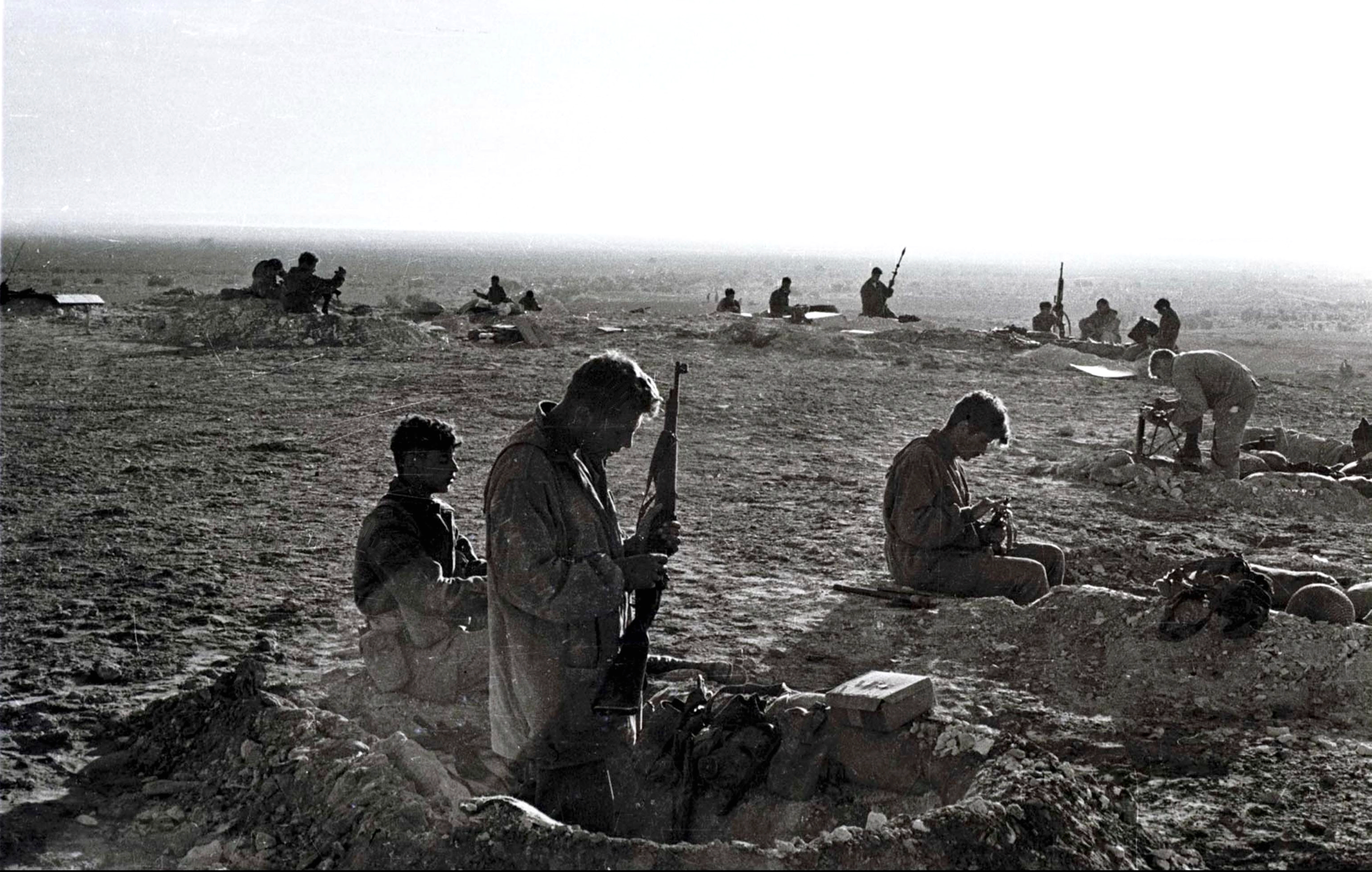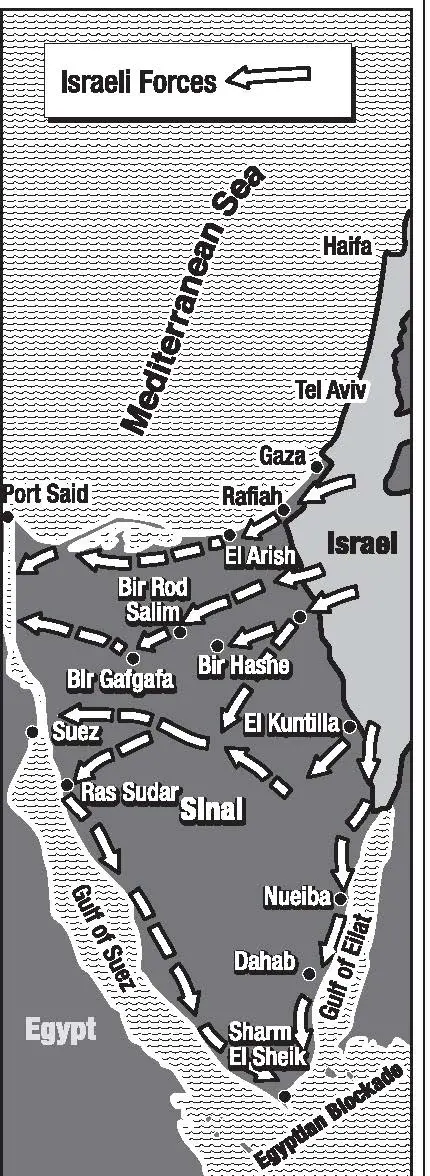The Sinai-Suez Campaign: Background & Overview
(October - November 1956)

In the fall of 1948, the UN Security Council called on Israel and the Arab states to negotiate armistice agreements. Egypt agreed, but only after Israel had routed its army and driven to El Arish in the Sinai. At that time, the British were ready to defend Egypt under an Anglo-Egyptian treaty. Rather than accept the humiliation of British assistance, however, the Egyptians met the Israelis at Rhodes.
UN mediator Ralph Bunche brought them together at the conference table and was later honored with a Nobel Peace Prize. He warned that any delegation that walked out of the negotiations would be blamed for their breakdown.
By the summer of 1949, armistice agreements had been negotiated between Israel and Egypt, Jordan, Lebanon, and Syria. Iraq, which had also fought against Israel, refused to follow suit. Bunche succeeded at Rhodes because he insisted on direct bilateral talks between Israel and each Arab state.
Meanwhile, on December 11, 1948, the General Assembly adopted a resolution calling on the parties to negotiate peace and create a Palestine Conciliation Commission (PCC), which consisted of the United States, France, and Turkey. All Arab delegations voted against it.
After 1949, the Arabs insisted that Israel accept the borders in the 1947 partition resolution and repatriate the Palestinian refugees before they would negotiate an end to the war they had initiated. This was a novel approach they would use after subsequent defeats: the doctrine of the limited-liability war. Under this theory, an aggressor may reject a compromise settlement and gamble on fighting to win everything in the comfortable knowledge that, even if he fails, he may insist on reinstating the status quo ante.
Egypt had maintained its state of belligerency with Israel after the armistice agreement was signed. The first manifestation of this was the closing of the Suez Canal to Israeli shipping. On August 9, 1949, the UN Mixed Armistice Commission upheld Israel’s complaint that Egypt was illegally blocking the Canal. UN negotiator Ralph Bunche declared: “There should be free movement for legitimate shipping and no vestiges of the wartime blockade should be allowed to remain, as they are inconsistent with both the letter and the spirit of the armistice agreements.”
On September 1, 1951, the Security Council ordered Egypt to open the Canal to Israeli shipping. Egypt refused to comply.
The Egyptian Foreign Minister, Muhammad Salah al-Din, said early in 1954:
A New Type of Warfare
 |
In 1955, Egyptian President Gamal Abdel Nasser began to import arms from the Soviet Bloc to build his arsenal for the confrontation with Israel. In the short term, however, he employed a new tactic to prosecute Egypt’s war with Israel. He announced it on August 31, 1955:
These “heroes” were Arab terrorists, or fedayeen, trained and equipped by Egyptian Intelligence to engage in hostile action on the border and infiltrate Israel to commit acts of sabotage and murder. The fedayeen operated mainly from bases in Jordan so that Jordan would withstand the worst of Israel’s retaliation, which inevitably followed. The terrorist attacks violated the armistice agreement provision that prohibited the initiation of hostilities by paramilitary forces; nevertheless, it was Israel that the UN Security Council condemned for its counterattacks.
The escalation continued with the Egyptian blockade of the Straits of Tiran and Nasser’s nationalization of the Suez Canal in July 1956. On October 14, Nasser made clear his intent:
Less than two weeks later, on October 25, Egypt signed a tripartite agreement with Syria and Jordan, placing Nasser in command of all three armies.
The continued blockade of the Suez Canal and Gulf of Aqaba to Israeli shipping, combined with the increased fedayeen attacks and the bellicosity of recent Arab statements, prompted Israel, with the backing of Britain and France, to attack Egypt on October 29, 1956.
Israeli Ambassador to the UN Abba Eban explained the provocations to the Security Council on October 30:
One reason these raids were so intolerable for Israel was that the country had chosen to create a relatively small standing army and to rely primarily on reserves in the event of war. This meant that Israel had a small force to fight in an emergency, that threats provoking the mobilization of reserves could virtually paralyze the country, and that an enemy’s initial thrust would have to be withstood long enough to complete the mobilization.
Great Power Collusion
Earlier, President Dwight Eisenhower had persuaded the British and French not to attack Egypt after Nasser nationalized the Suez Canal. When the agreement on the Canal’s use proved reliable over the succeeding weeks, it became increasingly difficult to justify military action. Still, the French and British desperately wanted to put Nasser in his place and recapture their strategic asset.
The French had grown increasingly close to the new Israeli government, politically, diplomatically, and militarily. The British attitude toward Israel had hardly changed from the mandatory period. Residual bitterness over the nearly three-decade-long battle fought with the Zionists, combined with the ongoing alliance with Jordan, discouraged any shift in policy.
The French concluded, however, that they could use Israel’s fear of Egyptian aggression and the continuing blockade as a pretext for their strike against Nasser. The British couldn’t pass up the chance to join in.
The three nations subsequently agreed on a plan whereby Israel would land paratroopers near the Canal and send its armor across the Sinai Desert. The British and French would then call for both sides to withdraw from the canal zone, fully expecting the Egyptians to refuse. At that point, British and French troops would be deployed to “protect” the Canal.
Israel Routs Egypt
 |
When the decision was made to go to war in 1956 – Operation Kadesh – more than 100,000 soldiers were mobilized in less than 72 hours, and the air force was fully operational within 43 hours. Paratroopers landed in the Sinai, and Israeli forces quickly advanced unopposed toward the Suez Canal before halting in compliance with the demands of England and France. As expected, the Egyptians ignored the Anglo-French ultimatum to withdraw. Considering themselves the “victims,” the Egyptians refused to retreat from the Sinai to the Canal’s west bank, while the Israelis were permitted to stay just 10 miles east of the Canal.
On October 30, the United States sponsored a Security Council resolution calling for an immediate Israeli withdrawal, but England and France vetoed it. The following day, the two allies launched air operations, bombing Egyptian airfields near Suez.
Given the pretext to continue fighting, the Israeli forces routed the Egyptians. The IDF’s armored corps swept across the desert, capturing virtually the entire Sinai by November 5. Former U.S. Ambassador Parker Hart said, “We had intelligence reports that many of the Egyptian troops just took off their shoes and ran barefoot to get out of there faster.” That day, British and French paratroops landed near Port Said, and amphibious ships dropped commandoes on shore. British troops captured Port Said and advanced within 25 miles of Suez City before the British government abruptly agreed to a cease-fire.
The British about-face was prompted by Soviet threats to use “every kind of modern destructive weapon” to stop the violence and the United States’ decision to make a much-needed $1 billion loan from the International Monetary Fund contingent on a cease-fire. The French tried to convince Britain to fight long enough to finish the job of capturing the Canal but succeeded only in delaying their acceptance of the cease-fire.
Though their allies had failed to accomplish their goals, the Israelis were satisfied at having reached theirs in an operation that took only 100 hours. By the end of the fighting, Israel held the Gaza Strip and had advanced as far as Sharm al-Sheikh along the Red Sea. A total of 231 Israeli soldiers died in the war.
Ike Forces Israel to Withdraw
President Eisenhower was upset that Israel, France, and Great Britain had secretly planned the campaign to evict Egypt from the Suez Canal. Israel’s failure to inform the United States of its intentions, combined with ignoring American entreaties not to go to war, sparked tensions between the countries. The United States subsequently joined the Soviet Union (ironically, just after the Soviets invaded Hungary) in a campaign to force Israel to withdraw. This included a threat to discontinue all U.S. assistance, UN sanctions, and expulsion from the UN (see exchanges between Ben-Gurion and Eisenhower).
U.S. pressure resulted in an Israeli withdrawal from the conquered areas without obtaining any concessions from the Egyptians. This sowed the seeds of the 1967 war.
One reason Israel gave in to Eisenhower was his assurance to Prime Minister David Ben-Gurion. Before evacuating Sharm al-Sheikh, the strategic point guarding the Straits of Tiran, Israel elicited a promise that the United States would maintain the freedom of navigation in the waterway. In addition, Washington sponsored a UN resolution creating the United Nations Emergency Force (UNEF) to supervise the territories vacated by the Israeli forces.
On the day of Israel’s withdrawal from Gaza (March 8, 1957), Menachem Begin spoke at a large rally in Tel Aviv demanding Ben-Gurion’s resignation. Demonstrators objected to what they viewed as a practically unconditional withdrawal that left hundreds of fedayeen in Gaza.
The war temporarily ended the activities of the fedayeen; however, they were renewed a few years by a loosely knit group of terrorist organizations that became known as the Palestine Liberation Organization (PLO).
Sources: Mitchell G. Bard, The Complete Idiot’s Guide to Middle East Conflict, 4th Edition, (NY: Alpha Books, 2008).
Parker T. Hart, Foreign Affairs Oral History Collection of the Association for Diplomatic Studies and Training, (August 12, 1988).
Gaza Withdrawal Completed; 10,000 Attend Protest Rally in Tel Aviv,
JTA, (March 8, 1957).
Photos: Paratroopers - IDF Spokesperson’s Unit via Wikimedia Commons.


